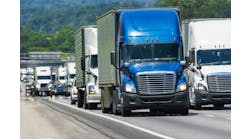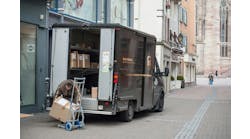| Life in the fast lane |
For production of its broad line of electric motors, U.S.-based A.O. Smith Electrical Products Co. (www.aosmithmotors.com) has run extensive just-in-time (JIT) operations at its eight maquiladora plants in Mexico. Until the last quarter of 2003, the company experienced the same frustrations and delays as other manufacturers along the southern border. Now that has changed — at least for one of its plants.
Since the U.S. Bureau of Customs and Border Protection (www.cbp.gov) opened FAST (Free and Secure Trade) at the El Paso-Juarez border crossing, product movement has picked up significantly.
“Today we are using the FAST lane and it is wonderful,” says Isela Mora, customs manager for A.O. Smith's Juarez operations. “We work in a JIT environment and the ability to use FAST lanes solves a lot of issues for us. Under older programs there were problems since occasionally we had to hold our production lines as much as two hours in order to furnish information to Customs. With FAST, we've cut the time for preparing and sending the paperwork to no more than 30 minutes.”
This scenario is a typical one for maquiladora work. Components to make the motors move to a consolidation warehouse in El Paso from a variety of U.S. sources. Shipments then move to the Juarez plant for final assembly. When motors are complete, they are sent back cross-border to the A. O. Smith distribution center (DC) in El Paso, in an industrial park close to the Saragosa Bridge between the two countries.
From the DC, complete motors move to the company's U.S. residential, commercial, industrial and agricultural customers. The company uses both Southwest Motor Freight and Menlo Worldwide Logistics (www.menlolog.com) for much of its product movement.
In order to be allowed to use FAST lanes, A.O. Smith had to be C-TPAT (Customs-Trade Partnership Against Terrorism) registered, which allowed it to apply for the use of a faster border-crossing lane. Generally, three components of crossing must be approved — the manufacturer, carrier and driver.
Moving finished motors northbound from Mexico is a bit of an involved process, since they must clear Mexican Customs before moving to U.S. Customs for clearance into El Paso. As Mora explains, “We have to file our reports with Customs when the trailers leave our plant to move to the border. We have to check drivers into and out of the plant, when they arrive, when they reach Mexican Customs, when they leave Mexican Customs to cross the border and when they reach U.S. Customs. And we do the same things southbound.”
Where previously, communication with Customs on both sides of the border had been done with paperwork, preparing invoices, packing lists, manifests, codes for U.S. and Mexican sides and all other information is passed electronically, with a big boost for A.O. Smith from trade management solution pro-vider Vastera Inc. (www.vastera.com).
The solution assists A.O. Smith with harmonized codes by building a trade database to serve as a passport for the goods at a part or SKU number level. Trade information includes tariff classifications, country of origin details, other government agency requirements and special trade program information, e.g., if goods are eligible for NAFTA rates.
Tom Collins, Vastera's project manager, Customs, points out that with increased focus on security, it's important to insure goods flow no slower than they do already. One way to do so is to take advantage of speedier clearance processes like FAST.
Collins closely monitors cross-border clearances and notes two methods of moving product through advanced noticed programs at the northern border: bar code and transponder. “The transponder approach to a FAST-dedicated lane is the best of all possible worlds, and Customs is moving toward that,” he says. “But where you have infrastructure problems — such as in the Detroit area — the full benefits of FAST will be a long time in coming. In Port Huron they have a two-stand bridge and have dedicated one lane to FAST. They've done the same thing in the Buffalo area.”
More than one carrier has noted that although FAST lanes exist, they work best for full truckloads. Less-than-truckload (LTL) carriers, with multiple shipments, must have all cargo pre-certified as FAST compliant or find themselves in longer lines at the border.
Keith Fleming, acting director, Cargo Verification Division, Office of Field Operations for U.S. Customs, says the government is aware of the situation but can do little since the need for security is of great importance at the country's borders. FAST is working well at the El Paso-Juarez border, he notes, and U.S. Customs intended to open the entire southern border by the end of January 2004. However, “We are not moving quite as rapidly as previously announced because the southern border is a bit different from the northern border, presenting a number of issues that must be resolved,” says Fleming.
He points to the fact, for example, that Mexico must clear product for export at the border before it ever arrives at U.S. Customs. Further, there are more strict regulations with reference to security matters for cargo that have to be met at the Mexico-U.S. border.
For the southern border point already open, it's working well for A.O. Smith's Mora. “Most of the time there are no problems in moving either north or south,” she notes. “We don't have any problems in preparing paperwork or sending information. Most of our problems are at the bridges when there may be terror alerts, which create long backups.”
No matter where products originate, keep U.S. Customs comfortable with business practices, notes Vastera's Collins. “A big security issue today has to do with anomalies in routing,” he says. “Companies in import and export activities should route goods in a predictable manner. A change in routing will draw Customs' attention. This is something to be aware of if you are going to change carriers or routing, methodology or even suppliers. Alert Customs first.” LT
Feedback on this article?
© Want to use this article?
Click here for options!
Copyright© 2004 Penton Media, Inc.


